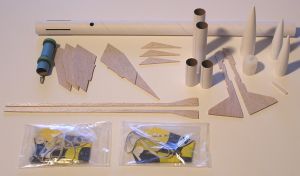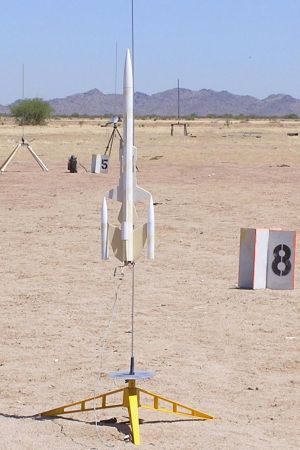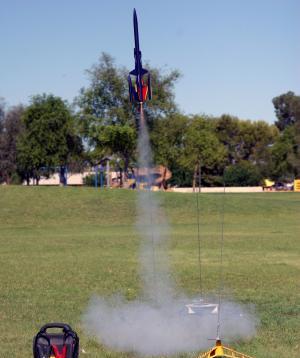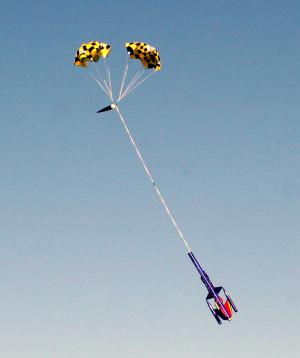| Manufacturer: | Estes  |

Brief:
"After numerous suspicious reports from the outer Alpha quadrant, we can now positively state that the Cediming have been using a new style Raider in their attacks at the Outer Rim Space Yard. There have been additional reports of attacks coming from the Outer Rim trading posts as well. Although actual sightings of the new craft have been few, reports are arriving documenting that the Cediming have managed to construct the new craft from the Space Yard's numerous old Gemini DC rockets and their parts. At great personal risk, some of our rim agents have managed to obtain one picture of the new craft on its launch pad. It appears to be unpainted and the actual color(s) of the craft are still a mystery, however, from the tone of the reports and some unconfirmed eyewitnesses, it appears our Strikefighters and Star Riders have had their hands full when confronting the Raiders! We will relay more information as we receive it!"
--G.M.K. for the Galaxy Press
Modifications:
Be very careful and take your time to separate the fins from the fin sheet as
the fins are not cut very well and will break in all the wrong areas. Use an
X-Acto knife with a very fine blade to separate the fins out of the sheet. Pay
special attention to the fin tab area so you can preserve the various notches.
They are not so important on the fins as they are on the leftover balsa piece
to maintain the edges that you can see on the finished rocket. This particular
kit had a very nice piece of hard balsa, which allowed me to turn the fin
around and still have a sturdy fin although the grain direction was not
optimal. That is the same condition with the fin/notched piece connected with
the outboard nose cones. However, this is a kit bash so it was not something
that could be changed and still stay within the rules. Titebond II glue was
used on all the wood and tube joints. CA was used to seal the two body tube
holes with a paper filler and plastic glue used for the nose cones.
 The major modification was with the fins. Using the fin guide,
cut the front of the fin off carefully and save the two pieces. Construction of
the rocket is straightforward with only a few "gotchas", which will
be noted.
The major modification was with the fins. Using the fin guide,
cut the front of the fin off carefully and save the two pieces. Construction of
the rocket is straightforward with only a few "gotchas", which will
be noted.
Take the body tube and using a doorframe, extend the center of the slots with a pencil line the entire length of the tube.
Start with the motor mount and build it according to the actual instructions. While that is setting up, this would be a good time to do the various sanding jobs. Take the main fins and sand all the edges equal with each other, following the original instructions. Do the same with the three smaller triangle pieces as well. The leftover balsa pieces are not quite equal but wait until the rocket is completed to the point where you are going to add these pieces and then sand them as needed to even them up to each other and still fit onto the rocket as well. These took the most time to fit and since this is not part of the way the original kit was designed to go together, sanding them now to even them up to each other will result in the parts not fitting onto the finished rocket by themselves.
Test fit the fins into the body slots and adjust the slots as necessary with sandpaper so that the fins are snug but not tight. The fins are placed on the rocket body turned 180 degrees from the way they were supposed to go on. (Backwards for those needing the simple explanation, sorry.) You will notice that they can slide up or back a bit and here is an area where your personal preference comes into play. With the motor mount in place in the body tube but not glued yet, add a fin or two and again adjust the fit of the fins into the slots and onto the motor mount. Trim the fin tab as necessary so that the fins are flush onto the body tube. I placed the fin/motor mount assembly on the low side so that a small part of the fin extended below the main body tube and appears to surround the motor tube from the outside. If you slide the mount up, the fins will be flush with the rear of the body tube. It's your choice! Once all of the large fins are fitted to your liking and you know which way you want to place them, remove them and the motor mount. Add the first thin layer of glue to the fin mounting surfaces so you will have double glue joints later. Do the same with the tip edge of the fin as well. Set these aside to dry.
Using a piece of the header card, cut a strip wide enough to cover the two holes in the body tube from the inside. Make sure the piece does not interfere with the placement of the motor mount. Once trimmed to your liking, fit the strip into the tube to cover the holes and use a pencil or piece of dowel to hold the paper tight to the hole from the inside and drop a little thin CA from the outside onto the area. CAUTION: these two holes must be completely sealed or the recovery system will not work and you will have a lawn dart! Once the motor mount and the fins are glued in place and dry, test the seal of the holes by placing the palm of one hand over the forward end of the body tube and blow into the motor end. If there is any air escaping use more glue to seal the holes tight! I used as little as necessary so that the depression left could still be seen.
Now is the time to glue the motor mount in and using one fin to set the mount in place, make sure it is in the position you want it to be. Align the motor hook between two of the fin slots. When satisfied the mount is where you want it, remove the fin and glue it back in place. Repeat with the other three fins. Make sure all the fins are flush with the body tube and aligned properly with each other and straight up from the tube. Once dry, add fin fillets at all the fin/tube joints. By the way, if you decide to build this thing, there are 7.5 feet of fillets. Yes, I (roughly) measured them! Check the finished tube seal again! Once that is completed, it's time to add the outer tubes.
Using a doorframe, draw a line the entire length of each of the tubes. These are to align the tubes with the fin edge. The small tubes are glued on the fin tips on two opposite fins and flush with the forward edge of the fin tip. The same is done with the large tubes. Use the alignment lines to get the tubes nice and straight with the body tube. Once dry, add fillets to these glue joints.
Using double glue joints throughout, add the small triangle fins, long side forward, one half inch in front of each of the large fins. To help with the alignment, take two Popsicle sticks and place them on both sides of the large fin and out far enough forward to capture the small fins as well. Hold the sticks in place with clothespins, one on the large fin and one on the smaller one. See my featured tip in the tip section for this one if you don't understand. Keep the sticks away from the glue joint or you will make a big mess when you try to rip them off! When dry, repeat with the other fins. However, since this is holding the small fin tight, you can do all of them together if you have the sticks and the pins. Don't add the fillets to these yet.
Using a generous amount of tube type plastic cement, glue the small nose cones to the front of the long outboard tubes. As you push the cone in, give it a few slow twists until you can feel the glue starting to grip. Wipe any excess glue from the joint right away all the way around and allow some time for the glue to set up. I let mine set up overnight.
Next up is the fin/notched piece. Here is where you will have to do some extra sanding and fitting. The piece has a slight cut on what would be the bottom rear side. This and the rear edge need to be fitted so that the piece fits onto the front of the small fin and up against the cone tip. Use the shorter of the two as your first piece. Sand and test fit until you have a nice smooth match up with the fin and the cone and the body tube. Use wood glue to attach this piece to the body tube and a small drop of CA where it meets the plastic cone. Use the alignment line on the body tube to get it nice and straight. Once dry, use this piece to shape and size the other fin/notched piece, fit to the other side, and glue in place. Now you can add the fillets to these pieces and the small fin as well. When dry, sand the wood around the nose cone to blend the wood into it.
Almost there! Take the long, thin balsa pieces and fit the shortest one to the front edge of the large fin with the long straight side away from the body tube and have it just touch the top of the small fin. Sand the forward edge of the strake so that it fits flush down onto the front of the body tube. The larger end of the strake is the end fitted to the large fin. When it fits well, glue it to the body tube on the alignment line and the fin. Use a drop of CA where this piece touches the top of the small fin. Repeat with the other piece. Add the fillets as needed and set to the side to dry.
When all the glue joints are dry, sand the leading edges and trailing edges of the balsa pieces round as needed. Some of these are a bear to get to and I'll leave it up to the builder as to how much punishment they want to endure! I left the top edge of the long thin piece flat just because that is where I got tired of sanding! Be extra careful at this point as some of the balsa pieces will be in your way and will get broken if you are heavy handed in your sanding!
The next pain in the %@#* phase is the filling of all the balsa grain. I use Elmer's Fill and Finish thinned out to paint it on with a small brush. Just remember, all of that stuff you put on has to be sanded off! Once you have punished yourself enough with that bit of fun, take the larger of the very small tubes and notch one end of it so that it will fit onto the front of one of the fin/notched pieces. This is your ion cannon. Glue in place once fitted to your liking and seal the back opening if you wish with white putty.
Last but not least, take the launch lug and cut it into two equal pieces. One piece is glued to the fin/body joint with the front of it even with the forward edge of the large wing and the other is glued to the same joint with the front of it even with the back edge of the notch on the fin/notched piece. I placed mine in one of the joints common with the engine hook location.
Take the two rubber shock cords and tie them together. Use the standard Estes tri-fold type mount to attach them to the inside of the body tube. Follow the original instructions for this except put the mount into the front of the main body tube. Attach the other end of the shock cord to the base part of the nose cone as well as the chute(s). I used both chutes in mine, and it is your choice if you use one or both chutes.
The nose cone has not been glued to its base yet for a reason. This is a totally new configuration for this rocket and must be checked for proper flight balance! If you have built this to these directions with a reasonable amount of glue, you will need to add 1/2oz of weight to the front of the nose cone. This will provide stability with up to a C6-7 engine. This is a very difficult rocket to swing test but if you can, it is the best way to insure that the rocket is balanced properly and will fly straight! Adding one full ounce will almost completely ensure a stable flight. These amounts were taken from a RockSim file that I made as well. If you can, check this file for the CG and CP points to check against your rocket. Always err on the side of caution. The little extra weight will not adversely affect the flight of this bird. When you are sure the rocket is balanced properly, glue the nose cone base to the nose cone with plastic cement.
Lastly, I used some of the header card again to make a few doodads to add some texture to the overall style. Again, it's your choice but just don't go overboard as it will again add excessive weight. If you do, make sure you recheck the balance one last time!


Construction:
This new rocket is the result of a kit bash of the Gemini DC kit from Estes. It
was conceived as an entry to the 2006 EMRR Challenge. Although the contest
rules stated that any and all of the parts from the original kit could be used,
or as few as needed, I gave myself the personal challenge to try to use every
single piece of material from the kit as well. This was accomplished as you can
see with the exception of the plastic bag! Even the name letters were use to
make the new name of this rocket! That's how Cediming came about. The long,
thin add on as well as the forward fin with the notches in it all came from the
leftover balsa from the fin sheet. The smaller triangular fin was taken from
the forward part of the original fin itself. The four rear tubes were cut from
the two smaller diameter tubes with the holes in them from the kit. The tubes
were cut just in front of and just behind the hole, resulting in the two small
and two long tubes that you see. Do not glue the base of the nose cone onto the
cone until the end!
Finishing:
The paint used was the automotive Duplicolor Mirage paint system. This is a
three part paint in some small rattle cans and sells for around $22. Following
the instructions, I painted the rocket in about two hours. It didn't look that
great at first except it was a nice purple color and it was about two days
later that I noticed the actual color shift. As it is rotated about, the rocket
goes from purple to blue to brown! Way cool! Lastly, after the paint had set up
for a few days, the original decals were used to accent the fins and the
outside edge of the small tubes.

Flight:
At almost 4oz dry weight, I knew a C6 engine would be good but didn't want to
overpower it on its first flight. There is a lot of balsa out in the breeze and
if it was misaligned at all, I didn't want a shred. First flight was on a B6-4.
A piece of Estes wadding was placed into the tube first followed with some
"dog barf". The two chutes were folded up and slid one by one into
the tube. There was enough room for two but one chute would be sufficient for a
slow recovery. I was using everything from this kit, remember?
It came time for launch and quite frankly I was not ready for the liftoff! I had my camera set for sequential shots and all the time I launched this thing, all I got was some great smoke shots. It really rips off the pad! All the flights have been straight with no twists or turns so my alignment concern never came up. Overall height ranged from about 500' to at least 800'. With the C engine, the rocket was just a very small dot at apogee which would place it in the 800' to 1000' range.
Recovery:
Ejection has been at or very close to apogee with each flight and both chutes
came out and deployed each time! The chutes give a very slow descent which
allowed no damage when landing but are not recommended for any kind of wind!
Even with less than 5mph winds, the rocket had a considerable amount of drift!
Summary:
This is a great changeover of the DC and turned into a really great flier in
the process. I never would have done this or even thought of it, if it wasn't
for the Challenge contest. Now that it is complete, it has become one of my
regular fliers! If you have a DC or two, try this conversion and you will amaze
your rocket buddies when they find out what the kit used to be!


I would like to give recoginition and much thanks to Moe and Gerald from the SSS club here in AZ for the last two great pictures of this review. The Raider was launched and recovered in a local park near my house and was flown with a B6-4 on that one.
The best part of this build was the fact that I had a kit that appeared to be not the best when built in stock form, although I will still take on that challenge with another one I have, and it was reborn into a great flier with some very appealing lines as well. I have enough kits and plans to keep me busy for many years and yet I very much enjoyed the challenge and the results of this kit bash!
 |
 |
Flights
Sponsored Ads
 |
 |











